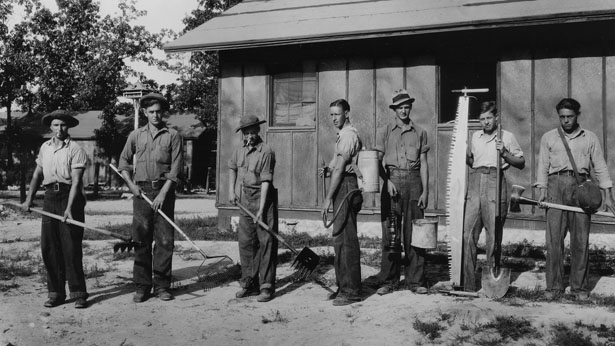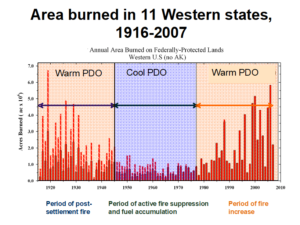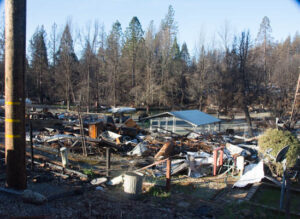
Forest rangers on horseback or mules roamed this land armed with shovels and axes to put out fires. Realistically how effective do you think that a couple of men with shovels covering millions of acres of wilderness could be at putting out fires? Photo: US Forest Service.
Hardly a day goes by when we don’t hear in the media and from the Forest Service that fire suppression is responsible for the intensity and size of wildfires.
According to proponents, a “hundred years of fire suppression” has permitted the build-up of fuels, and by their assertion, more fuel results in larger conflagrations.
However, at best, this “fire suppression” narrative is hyperbole.
Like all mythology, there is a kernel of truth. In some plant communities, particularly in dry pine forests of ponderosa pine, some fire suppression may be partially responsible for fuel build-up. It is thought that in these forest types frequent low severity fires kept fuels naturally low. However, fire suppression’s influence is greatly exaggerated for many plant communities in the West.
First, consider the timeframe that alleges a “hundred years of fire suppression.” In the early 1900s, much of the West, outside of valleys, was a virtual wilderness with limited road access, and of course, there were no air tankers or helicopters either.
Another issue with the “fire suppression” story is the methods used to create the story. Nearly all the evidence for fire suppression limiting wildfire is based on fire scar studies.
Scars are created when a fire burns but does not kill a tree, leaving behind a scar that will eventually heal over. There may be successive fire scars in long-lived trees, marking past fires.
However, the main problem with this method is that it only counts fires, not the geographical-spatial influence of fire. Since most fires are small, only burning one tree or a few acres, the majority of all fire scars record small fire events. The more small fires you include in your analysis, the shorter the fire interval, which may give a false impression of fire frequency and influence.
We know from a few studies, such as was done in Yellowstone National Park, that the majority of all fires self-extinguish without any human suppression.
Why is this important? Because simply documenting the occurrence of fires does not tell us much about the area burned.
For instance, a review of the 56,320 fires that burned over 9 million acres in the Rocky Mountains between 1980 and 2003 found that 98 percent of these fires (55,220) burned less than 500 acres and accounted for 4 percent of the area burned. By contrast, only 2 percent of all fires accounted for 96 percent of the acreage burned. And 0.1 percent (50) of blazes were responsible for half of the acres charred.
This and other observations suggest that most wildfires are not suppressed by humans but rather by nature.

Another fact ignored by the proponents of a “hundred years of fire suppression” is that in the 1920s and early 1930s, as many as 50 million acres were burned annually. Today, if 10 million acres burn, we consider it a “record” fire year. That certainly does not suggest fire suppression was “successful.”
The many years of large fires in the early 1900s coincides with a warm, dry climate that favored fire spread.
The converse of the drought years was the period between the 1940s and 1980s. At this time, the Pacific Decadal Oscillation created cool and moist conditions. As a result, there were fewer ignitions and slower fire spread.
Glaciers in the Pacific Northwest even grew during this cooler, moister midcentury period. Yet, it is a period when advocates claim fire suppression was “successful.” In reality, nature was successful in suppressing fires.
Today, with climate change, it is much warmer and drier-similar to the climate that prevailed during the early 1900s. So, climate change, not “fuels,” is driving the increased acreage burned.
A further problem with the fire suppression story is that nearly all plant communities in the West, including chaparral, sagebrush, juniper, true firs, lodgepole pine, hemlock and aspen, among others, tend to have long fire rotation intervals, often running into the hundreds of years. These plant communities only experience significant fires when climate and weather conditions are favorable to large blazes. They have been little influenced by fire suppression.
What is driving large wildfires across the West is not fuels. It is climate and weather. And that is one reason why fuel reductions, whether due to logging or prescribed burning, have at best a minor influence on large fires.
Indeed, a review of 1,500 blazes across the West found the highest severity (percentage of tree mortality) occurred in areas where logging or other “fuels management” prevailed. By contrast, wilderness areas and national parks where logging is prohibited thus had the greatest biomass (fuels) burned at lower severity.
Logging proponents often claim that thinning leads to the survival of more trees in thinned plots, thus storing carbon. However, proponents ignore that they have already removed (and killed) most of the trees in logging the site, releasing much of that carbon into the atmosphere.
One study estimates that logging releases five times the carbon as by wildfire, bark beetles, wind thrown, land use conservations and drought combined.
Although a small amount of carbon is released during a wildfire, the majority remains on-site stored for decades or centuries in the snags, roots, and even charcoal in the soil.
Trying to preclude large fires through fuel reductions is ineffective.
What can be done?
First protect as much publiclands from logging by enacting wilderness and park legislation like the Northern Rockies Ecosystem Protection Act, Colorado’s Core Act, Red Rock Wilderness Act, and other expansive wildlands legislation.
Instead of expanding thinning and logging on lands far from communities, spend federal and state funds helping communities to harden their homes to survive wildfires.

Paradise California was charred by the Camp Fire even though the entire town was surrounded by “fuel reductions”. Photo George Wuerthner.
As the recent Marshall Fire by Boulder, Colorado, located in grasslands with no forests, and others like the Camp Fire that destroyed 19,000 homes in Paradise, California, where past logging and fuel reductions did not affect fire spread, demonstrates that we need to focus on reducing the flammability of the home and the immediate area surrounding it.